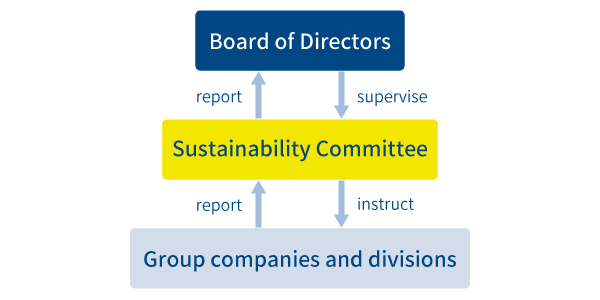- HOME/
- Sustainability/
- Environmental Conservation Initiatives
Sustainability
Environmental Conservation Initiatives
Climate Change and the TCFD
We recognizes that measures to protect the environment, including those to address climate change, represent both risks that could impact the sustainable growth of society and our business as well as opportunities to improve our competitiveness and create business opportunities. While promoting business management that considers the environment throughout the Group and disclosing information on our activities for addressing climate change and achieving a decarbonized society through our business activities in accordance with the recommendations of the Task Force on Climate-related Financial Disclosures (TCFD), we will aim to realize a sustainable society and increase our corporate value.

Governance
The Sustainability Committee was established to enhance the medium- to long-term corporate value and sustainable growth and to contribute to the creation of a sustainable society through our business activities. Its purpose is to identify and resolve materiality (material issues) surrounding sustainability, identify profit opportunities, and promote initiatives linked to the management plan, and the Committee is chaired by the President and CEO, and it is comprised of members selected by the Board of Directors. The Committee works with Group companies to develop and promote sustainability initiatives, and reports to the Board of Directors on issues considered by the Committee, with the Board of Directors overseeing the Committee.

Strategy
We recognize that measures to protect the environment, including those to address climate change, represent both risks that could impact the sustainable growth of society and our business as well as opportunities to create business opportunities and improve our competitiveness. We promote environmentally conscious management across the entire Group and disclose information on our activities for addressing climate change and transitioning to a decarbonized society in accordance with the recommendations of the Task Force on Climate-related Financial Disclosures (TCFD). We are committed to realizing a sustainable society and enhancing corporate value.
Scenarios Used
In examining risks and their impacts on the Group, the Sustainability Committee referred to the “TCFD Guidance for the Real Estate Sector” published by the Ministry of Land, Infrastructure, Transport and Tourism, and assessed the impacts of climate change risks and opportunities on business activities based on the 1.5°C and 4°C scenarios. We will continue to analyze and study the financial impacts of risks and opportunities and develop a business strategy that incorporates response measures.
1.5°C Scenario
A scenario in which strict measures are taken to combat climate change, and in 2100, the rise in temperature compared to the period of the Industrial Revolution will be limited to around 1.5°C.
4°C Scenario
A scenario in which strict measures against climate change are not taken and the temperature in 2100 will rise by about 4°C compared to the period of the Industrial Revolution.
| Classification | Impact Items | Business Impact |
|---|---|---|
| Transition Risks | Increased costs due to the introduction of a carbon tax, etc. |
|
| Decline in demand due to increased response costs from the introduction of environmental building regulations |
|
|
| Increased costs of switching to new technologies and equipment | Increase in costs due to environmental response measures at owned properties and decline in building value of non-compliant properties. | |
| Decline in evaluation and value due to delays or lack of action in addressing environmental measures |
|
|
| Physical Risks | Increased risk of building damage and business shutdown due to intensification of natural disasters |
|
| Increased operating costs due to higher average temperatures |
|
| Opportunities | Growing demand for environmentally certified real estate | Increased demand for new construction and reconstruction due to growing preference for buildings with environmental certifications. |
|---|---|---|
| Lower construction costs due to innovations in environmentally friendly technologies | The evolution of environmentally friendly technologies has spread to improved performance of solar panels, building materials and equipment, and the lowering of environmental response costs has led to a reduction in equipment renewal costs and management/operating costs for owned properties. |
Indicators and Targets
Recognizing that climate change poses both a risk to society and the Company's sustainable growth as well as an opportunity to create business opportunities and improve competitiveness, the &Do Holdings Group, led by the Sustainability Committee, is developing a system to calculate total greenhouse gas (CO2) emissions in order to assess and manage the impact of efforts for environmental conservation, including climate change, on management. We have begun compiling Scope 1 direct emissions and Scope 2 indirect emissions from energy sources as defined by the TCFD, and will continue to enhance information disclosure in line with the recommendations of the TCFD.
Greenhouse Gas Emissions, consolidated group
unit:tCO2| Scope1 | Scope2 | |
|---|---|---|
| FY2023 | 112 | 629 |
| FY2024 | 153 | 627 |
* The scope of calculation is consolidated Group companies.
* For Scope 1, usage is calculated based on the distance traveled by vehicles used for business purposes, assuming that all gasoline vehicles are used.Since the fiscal year ended June 2024, we have expanded the scope of measurements to include occasional vehicle use.
* For rental properties for which Scope 2 consumption cannot be calculated, we estimate the amount using a reference unit price provided by the Home Electric Appliances Fair Trade Conference (hereinafter the “Conference”) based on the aggregated sales electricity volume and sales amount of all retail electricity providers, as published in the “Electricity Trading Report” by the Electricity and Gas Market Surveillance Commission of the Ministry of Economy, Trade and Industry.
